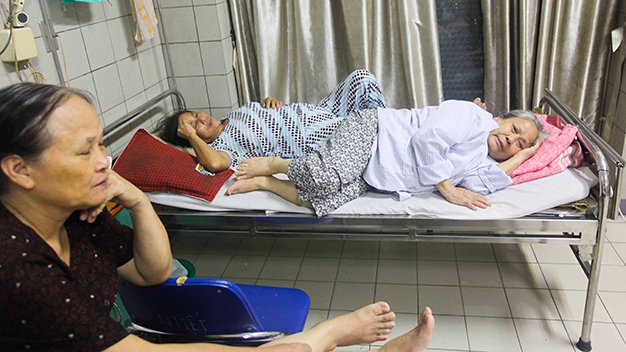The Vietnamese Ministry of Health has recently published a list of 13 major hospitals which have been committed to terminating bed sharing between patients by February 27 this year.
Included among the hospitals are the Hanoi-based Bach Mai Hospital, Central Hue Hospital, Central Thai Nguyen Hospital, Central Dermatology Hospital, E Hospital, Viet Duc Hospital, Central Hospital for Tropical Diseases, and Vietnam-Cuba Dong Hoi Hospital.
Another 25 major hospitals are also expected to have no bed sharing cases by the end of 2015. The commitment was made at an online conference held by the Ministry of Health on January 20.
Le Thanh Hai, director of the Central Pediatrics Hospital, shared a real experience that he said inspires the hospital’s commitment to terminating bed sharing.
“In early 2014, more than 120 children died during the measles outbreak due to hospital-acquired infections and bed sharing. In the last four months, we haven’t had any case of bed sharing thanks to many measures,” Hai said.
A reporter in Hanoi’s Cau Giay District countered that her child, who was treated at the hospital’s allergy department from January 5 to 12, had to share the same bed with two other children.
The room was stuffy due to overload and even included children with pneumonia. Her family had to wait until the evening to rent a bed for VND680,000 (US$31.8), VND60,000 ($2.81) of which was for water and electricity.
Dang Huy Quoc Thinh, deputy director of Ho Chi Minh City Oncology Hospital, said that the infirmary only has 644 in-patient beds available while the real number of patients reached 1,438, which means two to three people have to share a bed.
Nguyen Truong Son, director of Cho Ray Hospital in Ho Chi Minh City, stated that the hospital is facing the most in-patients overload and two patients still have to share one bed in most departments.
In 2010, the hospital was expected to have a total of 1,800 sickbeds, whilst the number of beds in reality was only 1,623. In 2014, this number hit 2,402, of which 600 are stretchers or portable beds which were put in a room or along a hallway, whereas the hospital serves around 2,500-2,600 in-patients per day.
In 2013, Cho Ray Hospital received a total of 117,803 in-patient visits, while this number was 123,189 in 2014, an increase of five percent, which forced the hospital to add more stretchers and prioritize the needs of 10 departments facing the worst overcrowding.
“The hospital’s in-patient bed capacity is confronted with serious overcrowding. We will try to make sure that an in-patient will be able to stay in one bed by the end of 2015. Our new cancer center with 250 sickbeds will begin operations by the end of April,” Son said.
Cho Ray Hospital also has a number of measures against in-patient overload and bed sharing such as improving professional quality, applying new techniques for early and accurate diagnosis and rapid recovery treatment for early discharge, thus decreasing the length of hospital stay.
There are three criteria for hospitals to register for the group of infirmaries without bed sharing, including a requirement that a hospital must arrange one bed for only one patient right after or up to 48 hours after a patient enters in-patient treatment.
Patients are encouraged to report to the hotline of the Ministry of Health when a hospital cannot keep its commitment and still lets patients share a bed.
Overcrowding is partly blamed on a strong influx of patients from other provinces to the city’s hospitals.
The Ho Chi Minh City Oncology Hospital, with 630 beds, is treating about 12,000 patients, 70 percent of whom are from outside the city, according to statistics shared at a meeting held in late February last year.
Like us on Facebook or follow us on Twitter to get the latest news about Vietnam!






















































